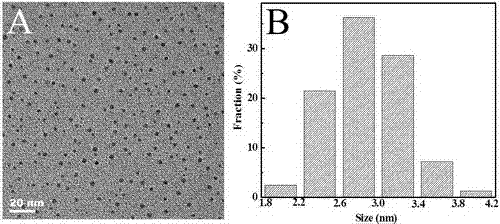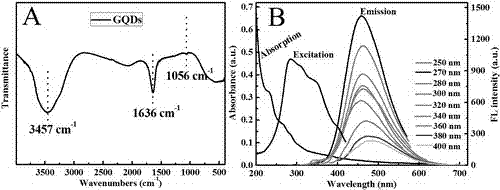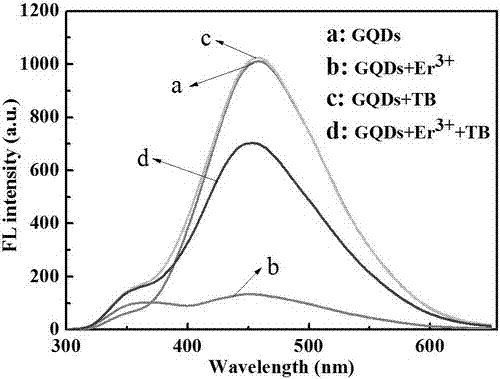Thrombin detection method based on graphene quantum dot/ erbium ion fluorescent nano probe
A fluorescent nanoprobe, graphene quantum dot technology, applied in the field of optical sensing, can solve complex price, time-consuming, expensive and other problems, and achieve the effect of good selectivity and high sensitivity
- Summary
- Abstract
- Description
- Claims
- Application Information
AI Technical Summary
Problems solved by technology
Method used
Image
Examples
Embodiment 1
[0019] Preparation of GQDs
[0020] (1) Add 1.0 g of carbon powder, 60 mL of concentrated nitric acid and 180 mL of concentrated sulfuric acid into a 250 mL reaction flask in sequence, and sonicate for 2 h at 100% power;
[0021] (2) The above solution was refluxed at 120 °C for 24 h, and the mixture was diluted to 800 mL with ultrapure water to obtain a dark brown solution, which was washed with Na 2 CO 3 The pH of the neutralization solution is about 7, and most of the sodium salt is removed by concentration and filtration, and the filtrate is dialyzed in 1000Da dialysis bags for 3 days in batches. The products in the dialysis bags are GQDs, and the GQDs are dispersed in ultrapure water for later use.
[0022] The prepared GQDs were characterized by transmission electron microscopy (TEM), infrared spectroscopy, ultraviolet-visible absorption and fluorescence spectroscopy. Depend on figure 1 A shows that the GQDs synthesized by the method of the present invention are in th...
Embodiment 2
[0024] GQDs and Er 3+ and the interaction mechanism of thrombin
[0025] Prepare GQDs, GQDs / Er with Tris-HCl buffer solution 3+ , GQDs+TB and GQDs / Er 3+ +TB solution, add ultrapure water to bring the total volume of the test solution to 200 μL, shake it well, measure the fluorescence spectrum of the solution when the excitation wavelength is 270 nm, the final concentration of Tris-HCl buffer solution is 50 mM and the pH is 7.0, GQDs 12.5 μg / mL, Er 3+ 15 μM for TB and 20 nM for TB. Depend on image 3 It can be seen that GQDs have a strong emission peak at 456 nm (curve a); when adding Er to GQDs 3+ After that, the fluorescence of GQDs is greatly reduced (curve b); when GQDs and Er 3+ When TB was added to the mixed solution of GQDs, the fluorescence of GQDs was enhanced (curve d); however, when TB was added to the GQDs solution, the fluorescence of GQDs remained unchanged (curve c).
[0026] GQDs and Er 3+ To characterize the interaction between ( Figure 4 A), the dynami...
Embodiment 3
[0028] GQDs / Er 3+ Composite fluorescent nanoprobes for the detection of TB
[0029] 10 μL of 0.25 mg / mL GQDs solution, 20 μL of 150 μM Er 3+ solution, 20 μL of 50 mM Tris-HCl buffer solution with pH 7.4 and different concentrations of thrombin solutions were mixed, and ultrapure water was added to bring the total volume of the test solution to 200 μL, shaken and shaken, and the fluorescence of the solution was measured when the excitation wavelength was 270 nm spectrum. Depend on Figure 5 It can be seen that with the increase of TB concentration, the fluorescence of GQDs gradually increases, and the fluorescence intensity of GQDs has a good linear relationship with the TB concentration in the range of 0.1-6 nM, and the linear correlation coefficient R 2 =0.993, the detection limit of TB is 0.049 nM, which can realize the sensitive detection of TB.
PUM
 Login to View More
Login to View More Abstract
Description
Claims
Application Information
 Login to View More
Login to View More - R&D
- Intellectual Property
- Life Sciences
- Materials
- Tech Scout
- Unparalleled Data Quality
- Higher Quality Content
- 60% Fewer Hallucinations
Browse by: Latest US Patents, China's latest patents, Technical Efficacy Thesaurus, Application Domain, Technology Topic, Popular Technical Reports.
© 2025 PatSnap. All rights reserved.Legal|Privacy policy|Modern Slavery Act Transparency Statement|Sitemap|About US| Contact US: help@patsnap.com



